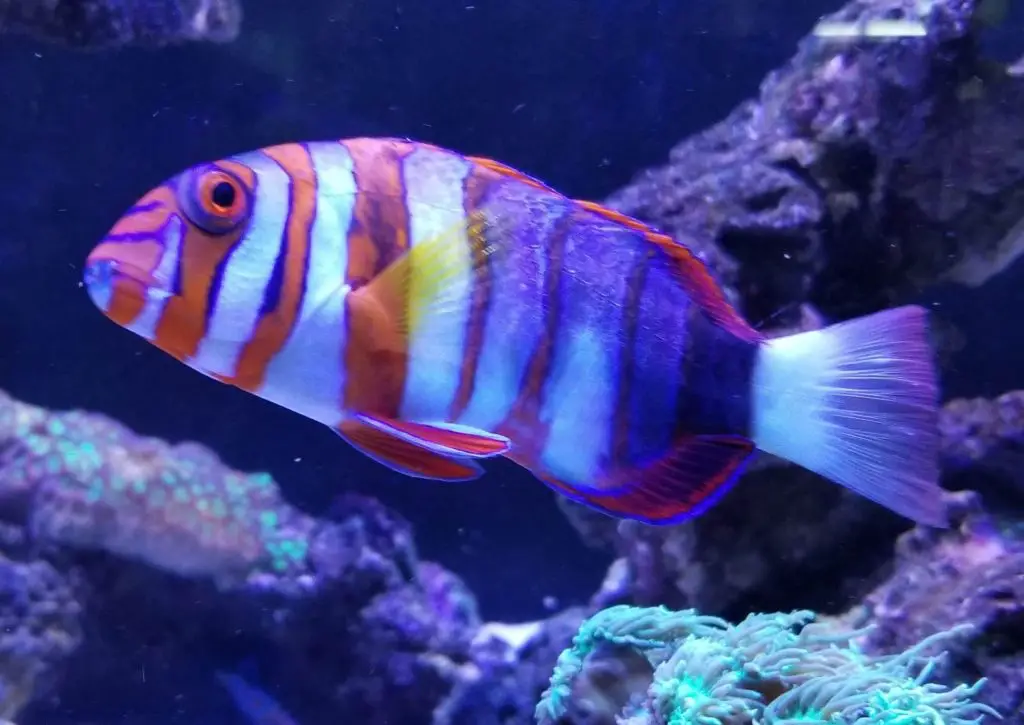
I had a Harlequin Tusk fish in my 210-gallon marine fish tank for about 1.5 years.
When I first acquired the 210-gallon tank from a fellow reefer, the Harlequin Tusk was one of the included fish in the sale. I enjoyed having the Harlequin Tusk and it was a show-stopping centerpiece of the tank. I eventually moved on from the fish as my preference is for peaceful community reef tanks and Harlequin Tusk Wrasse’s can be aggressive and will eat any inverts you try to house in the tank. Read on to learn more about the Harlequin Tusk Wrasse and my personal experience in having one in my reef tank.
What is the Harlequin Tusk Wrasse?
The Harlequin Tusk fish is a member of the Wrasse family. It is a colorful fish with silver, orange, and other vibrant colors. The Harlequin Tusk Wrasse has large teeth that stick out of its mouth that it uses to catch and crush prey especially inverts.
The fish is a carnivorous fish and in the reef aquarium will spend its time swimming about the aquarium and hanging out in caves within live rock structures. The Harlequin Tusk Wrasse is collected from Australian and Indonesian waters. The Australian Harlequin Tusk Wrasse usually has a bit more vibrant coloration and is usually a bit more costly when you can find them. The fish is considered to be on the aggressive side and will eat fish that fit into its mouth and will eat inverts in the reef aquarium.
Is the Harlequin Tusk Wrasse Reef Safe?
The Harlequin Tusk Wrasse is considered reef safe in the home aquarium. In my 210-gallon reef tank, I house mushrooms, zoas, euphyllia, acros, and some soft corals. I have never seen my Harlequin Tusk nip or eat any corals. The fish seems to stick primarily on its carnivorous side and leaves coral alone. These fish are powerful swimmers and can grow very large. I have seen my tusk knock over coral frags and break off pieces when swimming hard in the tank. If you keep a Harlequin Tusk Wrasse with corals, make sure they are secure to live rock. I like to glue a piece of epoxy to the bottom of the frag/coral and then superglue the bottom of the epoxy where it connects to the live rock in your tank. I found this to provide a nice stable frag when mounted in the tank.
What is the temperament of the Harlequin Tusk Wrasse?
I would characterize the Harlequin Tusk Wrasse as an aggressive fish. The fish is a carnivorous fish that lives up to that type.
The smallest fish I’ve kept in the tank with the Harlequin Tusk Wrasse were 2 small Clownfish and a small Blue Chromis Damselfish. I have seen on many occasions the Harlequin Tusk Wrasse try to eat these small fish, but ultimately didn’t follow through. The Tusk would swim up to the fish and open its mouth wide. The fish seemed to just not fit into its mouth, so it never actually ate its tank mates. I never did see the Tusk go after anything larger than these small fish, and it seemed to be a lower-ranking to a blue hippo tank, sailfin tang, and a purple tang that were of similar size to the Tusk.
The one thing that was the biggest detractor for me with the Harlequin Tusk Wrasse is the ability to keep inverts in the tank. The Harlequin Tusk Wrasse will eat any invert that makes its way into the tank including hermits, snails, and shrimp. It will also eat any fire worms it finds in the tank. I like to have a cleanup crew of inverts in the tank for clean-up and to add another layer of life to the tank. This was ultimately the reason why I ultimately got rid of my Harlequin Tusk Wrasse.
I found my Harlequin Wrasse to be a very intelligent and inquisitive fish. My Harlequin Wrasse was never shy and was openly swimming throughout the tank throughout most of the day. Anytime I would be near the tank the Tusk would come and investigate and was ready to be feed. Anytime I would place my hand in the tank the Tusk would swim right up to it to investigate. I was afraid that it might bite with those large teeth, but it never did.
What is the ideal environment for a Harlequin Tusk Wrasse?
The Harlequin Tusk Wrasse can grow to be a large fish and I would recommend it goes in a tank no less than 125 gallons so it has ample room to roam. This fish can grow to a size of 8 – 12″. The Harlequin Tusk also likes to hang out in crevices and caves. A nice live rock structure for it to house in is optimal for keeping this fish. I would also recommend the fish be kept with similar-sized fish and temperaments.
Inverts should not be kept with the Harlequin Tusk Wrasse. Coral can be kept in the aquarium with this fish. My Harlequin Tusk ate just about any food it was offered. I usually feed a combination of flake, pellet, and frozen foods.
Where to get a Harlequin Tusk Wrasse?
The Harlequin Tusk can be a bit tough to find at times. The fish is on the pricier side of your typical marine fish and is typical seasonal as to when they are available. The best way to find a Harlequin Tusk Wrasse is to ask your local fish store to see if they can acquire one for you. They usually will know when they are available or might even know of somebody who is looking to get rid of one. The other option is to check online vendors and sign for email alerts when they become available.
ReefSumper’s Overall take on the Harlequin Tusk Wrasse
Ultimately I gave my Harlequin Tusk Wrasse to my local fish store and was given a nice in-store credit for the fish. The fish is nice looking, inquisitive, intelligent, and somewhat rare in the hobby but it just didn’t fit the type of tank that I like to have. I like to have peaceful community tanks where fish coexists well or even are beneficial to each other one way or another. Inverts and a solid cleanup crew are something I like to have in my tanks and this is not possible with Harlequin Tusk Wrasse.
Harlequin Tusk Wrasses are very opportunistic feeders and I’m sure mine would have obliterated any invert placed in the tank.
If your tank type is on the semi to aggressive side without inverts, the Harlequin Tusk Wrasse is an awesome addition. With its striking colors and big tusk teeth, the fish is an awesome specimen to have and observe in the reef tank.
